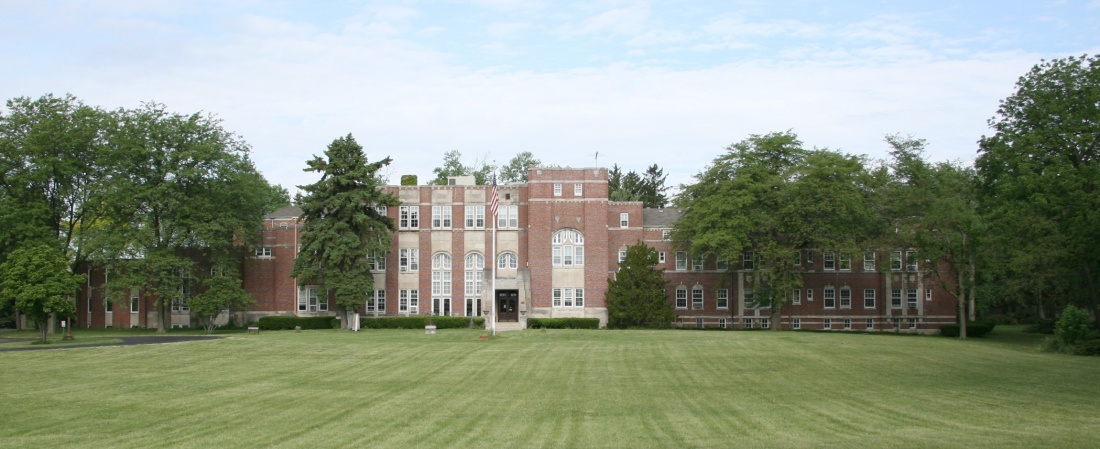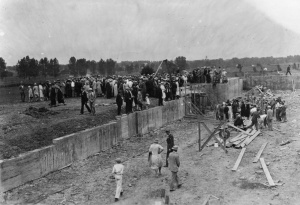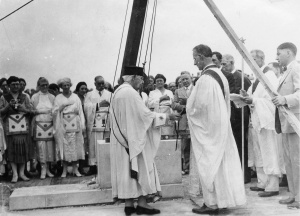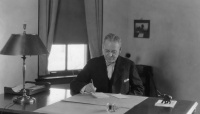L. W. Rogers Building: Difference between revisions
No edit summary |
No edit summary |
||
| Line 1: | Line 1: | ||
[[Category:Places]] | [[Category:Places]] | ||
[[File: | [[File:Rogers_Building_1a.jpg|1100px|thumb|left|L. W. Rogers Building, front view, 2007. Photographer Jeff Gresko. Image from the Theosophical Society in America Archives.]] | ||
== History == | == History == | ||
In 1925 the [[American Theosophical Society]], now known as the [[Theosophical Society in America]], purchased land in Wheaton, Illinois for a new headquarters campus. The Board of Directors approached architect [[Claude Bragdon]], a prominent member of the Society, to design a building to serve as | In 1925 the [[American Theosophical Society]], now known as the [[Theosophical Society in America]], purchased land in Wheaton, Illinois for a new headquarters campus. The Board of Directors approached architect [[Claude Bragdon]], a prominent member of the Society, to design a building to serve as the national administrative center. Bragdon was then closing down his architectural practice to begin a career in theatrical design, and recommended a Chicago architect, Irving Kane Pond, of Pond & Pond, Martin & Lloyd, to take on the project. The architectural firm submitted two designs, and the Board could not decide between them, so President [[L. W. Rogers]] sent the drawings to Bragdon for review. Bragdon wired back that he preferred the asymmetrical design by Irving Pond over a symmetrical rendering by one of his partners. | ||
== Construction == | == Construction == | ||
[[File:Cornerstone_crowd.jpg|300px|thumb|left|Crowds gathering for cornerstone ceremony. Image from TSA Archives]] | |||
[[File:Cornerstone_crowd.jpg|300px|thumb| | |||
[[File:Cornerstone_1.jpg|300px|thumb|right|Annie Besant in cornerstone ceremony. Image from TSA Archives]] | [[File:Cornerstone_1.jpg|300px|thumb|right|Annie Besant in cornerstone ceremony. Image from TSA Archives]] | ||
Construction began in 1926, and the cornerstone was laid on August 29th in a Co-Masonic ceremony led by Annie Besant. The event was heavily covered by the Chicago Tribune and other newspapers, and people came by the hundreds on the interurban trains from Chicago to be present. In the photograph to the right, Annie Besant and A. P. Warrington are in front; L. W. Rogers appears between them; and architect Irving Kane Pond is third from the right (older man in dark suit). Jiddu Krishnamurti accompanied Annie Besant to Wheaton, but he does not appear in photographs of the ceremony. The architect mentioned the event in his autobiography. | |||
[[File:Rogers_Building_Dedicaton.jpg|200px|thumb|right|George S. Arundale at building dedication, August, 1927. Image from TSA Archives.]] | [[File:Rogers_Building_Dedicaton.jpg|200px|thumb|right|George S. Arundale at building dedication, August, 1927. Image from TSA Archives.]] | ||
A dedication ceremony was conducted by the international president of the Theosophical Society, [[George S. Arundale]] in August 1927, and | A dedication ceremony was conducted by the international president of the Theosophical Society, [[George S. Arundale]] in August 1927. He appears in the middle of the photograph which appeared in the ''Chicago Tribune''. His wife [[Rukmini Devi Arundale|Rukmini Devi]] and L. W. Rogers are at the left, and A. P. Warrington at the far right. In September the staff moved the offices from Chicago. | ||
== Architecture == | == Architecture == | ||
The architecture of Irving Kane Pond is difficult to classify, but the Rogers Building is considered to | The architecture of Irving Kane Pond is difficult to classify, but the Rogers Building is generally considered to be Collegiate Gothic in style, with interiors influenced by the Arts and Crafts Movement. The exterior was constructed of Bedford limestone and red brick, with a carved stone lintel over the main entrance. The original roof was a mixture of purple and green slates.The building's asymmetrical design helps to create an impression that the building evolved organically over time, adjusting to the needs of its inhabitants. In point of fact, the exterior appearance has hardly changed over the years, and most spaces in the building are still used for the same functions they were designed to support. | ||
== Lobby == | == Lobby == | ||
The lobby | |||
== Offices == | == Offices == | ||
| Line 59: | Line 61: | ||
In 2010, the basement kitchen and dining area were extensively remodeled. The dining room was renamed Nicholson Hall in honor of the Nicholson family whose generous donation made the renovation possible. | In 2010, the basement kitchen and dining area were extensively remodeled. The dining room was renamed Nicholson Hall in honor of the Nicholson family whose generous donation made the renovation possible. | ||
== Notes == | |||
<references/> | |||
== Additional resources == | |||
Theosophical Society in America Archives have architect's drawings, 1926 blueprints, correspondence, and detailed specifications for each subcontractor (plumbing, roofing, etc.) | |||
Revision as of 04:03, 7 February 2012
History
In 1925 the American Theosophical Society, now known as the Theosophical Society in America, purchased land in Wheaton, Illinois for a new headquarters campus. The Board of Directors approached architect Claude Bragdon, a prominent member of the Society, to design a building to serve as the national administrative center. Bragdon was then closing down his architectural practice to begin a career in theatrical design, and recommended a Chicago architect, Irving Kane Pond, of Pond & Pond, Martin & Lloyd, to take on the project. The architectural firm submitted two designs, and the Board could not decide between them, so President L. W. Rogers sent the drawings to Bragdon for review. Bragdon wired back that he preferred the asymmetrical design by Irving Pond over a symmetrical rendering by one of his partners.
Construction
Construction began in 1926, and the cornerstone was laid on August 29th in a Co-Masonic ceremony led by Annie Besant. The event was heavily covered by the Chicago Tribune and other newspapers, and people came by the hundreds on the interurban trains from Chicago to be present. In the photograph to the right, Annie Besant and A. P. Warrington are in front; L. W. Rogers appears between them; and architect Irving Kane Pond is third from the right (older man in dark suit). Jiddu Krishnamurti accompanied Annie Besant to Wheaton, but he does not appear in photographs of the ceremony. The architect mentioned the event in his autobiography.
A dedication ceremony was conducted by the international president of the Theosophical Society, George S. Arundale in August 1927. He appears in the middle of the photograph which appeared in the Chicago Tribune. His wife Rukmini Devi and L. W. Rogers are at the left, and A. P. Warrington at the far right. In September the staff moved the offices from Chicago.
Architecture
The architecture of Irving Kane Pond is difficult to classify, but the Rogers Building is generally considered to be Collegiate Gothic in style, with interiors influenced by the Arts and Crafts Movement. The exterior was constructed of Bedford limestone and red brick, with a carved stone lintel over the main entrance. The original roof was a mixture of purple and green slates.The building's asymmetrical design helps to create an impression that the building evolved organically over time, adjusting to the needs of its inhabitants. In point of fact, the exterior appearance has hardly changed over the years, and most spaces in the building are still used for the same functions they were designed to support.
Lobby
The lobby
Offices
Meditation room
The meditation room is a serene space used only for meditation or meditation classes. Staff members gather every morning at 8:30 for 15 minutes for a group practice, and a healing group meets each Wednesday evening. Beautiful art works and oriental carpets line the room, including a thanka presented by the Dalai Lama in 1981 and a painting of Helena Petrovna Blavatsky by Gutzon Borglum, sculptor of Mount Rushmore. Just outside the doors of the meditation room are two pastels by Theosophist Burton Callicott They are Mandorla and Antahkarana
Library
The Henry S. Olcott Memorial Library, formerly known as the Olcott Library and Research Center, is a beautiful space that is used for meetings and performances as well as traditional library activities.
The library was expanded in 1964 to add space on three levels. The architect was Lillian Leenhouts of
Auditorium
The third-floor auditorium is used for lectures, workshops, yoga classes, conferences, and numerous other activities throughout the year. The space was remodeled in 2009, benefiting from the Bland administration's Capital Funds Campaign. A column was removed to improve sight-lines for the audience. The sub-floor was rebuilt and new carpeting was installed. Co-Masons donated a beautiful door and door frame featuring stained glass with the Society's emblem etched into it. New audiovisual equipment was installed to support Webcasts and recording of programs.
Art gallery
The anteroom to the auditorium is an art gallery with exhibits changed every 6-8 weeks.
Dining room
In 2010, the basement kitchen and dining area were extensively remodeled. The dining room was renamed Nicholson Hall in honor of the Nicholson family whose generous donation made the renovation possible.
Notes
Additional resources
Theosophical Society in America Archives have architect's drawings, 1926 blueprints, correspondence, and detailed specifications for each subcontractor (plumbing, roofing, etc.)



